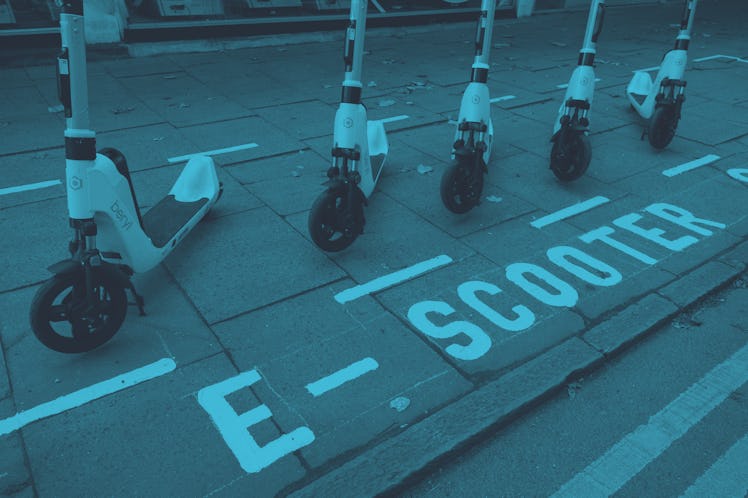E-Bike and Scooter Injuries Are Surging — Here's What Parents Need To Know
Pediatricians are sounding the alarm on the rise in e-vehicle injuries in kids — and how to prevent them.

Electric bikes and scooters were under a lot of Christmas trees this week — kids all over the country are zipping down sidewalks, no pedaling or pushing required. E-vehicles are undoubtedly a blast, but new research finds that there’s significant risk involved with these popular new toys.
According to recent data from the Consumer Product Safety Commission (CPSC), e-vehicles are responsible for a significant surge in injuries, accounting for 13,557 pediatric injuries between 2020 and 2021, and 360,800 emergency department visits from 2017 to 2022, for all age groups. The CPSC also found that injuries increased 22% from 2021 to 2022, and that kids under age 14 accounted for 36% of the injuries in that time frame, despite making up only 18% of the U.S. population.
The most commonly reported injuries were fractures, contusions, and abrasions, and the most commonly injured part of the body was the head — 67% of those with head injuries reported not wearing a helmet.
Why kid-powered e-vehicles can be dangerous
E-scooters and e-powered vehicles for kids may be super fun, but they pose unique risks.
Even the most skilled riders will have to avert a potential collision at one point or another. On a traditional kid-powered scooter or bike, kids tend to either slam on the breaks or “freeze” and stop pedaling. On an electric bike or scooter, however, kids can accidentally accelerate toward obstacles. The panicked pull of the wrong handle can send children careening forward into the very thing (a tree, a crack in the sidewalk, a person) they were trying to avoid.
Because scooters have small tires, and no shock absorption mechanism, bumps or holes in the ground can cause more turbulence — add power to that, and you have a kid going much, much faster than they would on their manually powered scooter, hitting cracks and bumps and potentially setting themselves up for a nasty fall.
If your kids have an e-vehicle...
- Insist on helmets. Head injuries were the most common micro-mobility-related injury, and though it seems obvious, many riders eschew helmets. Ensure that your kids use a helmet every single time they ride, and make sure that the helmet is worn appropriately, i.e., the chin strap is attached, has adequate fit, and covers the entire top of the head.
- Ensure they ride on even, flat ground. Many accidents were found to be the result of falls on uneven ground or potholes.
- Teach kids to ride safely. Riders should lean back and slow down when approaching small obstacles like bumps or sidewalk cracks and always keep both hands on the handlebars to maintain control.
- Inspect micro-mobility vehicles before each use. Check out cables and wiring, handlebars, riding deck, battery, and other components for damage before riding each time.
- Install a bell, horn, or other noise-making device. All electric vehicles are quiet, and motorists, cyclists, or pedestrians may not hear them coming. Installing a bell or horn will allow your child to alert those nearby to their presence.
What to do if your kid gets hurt on an e-scooter or e-bike
According to Dr. Alexis Monique Javier, a pediatrician with Children’s Memorial Hermann Pediatrics, a parent’s first job is to assess the location they fell in.
“If the child ends up falling or hurting themselves while they're on one of these things, the first thing is just to make sure that one, they're in a safe spot,” Javier explained. “So if they're not, move into a safe spot. If they have a head injury, then definitely you don't want to move their head or their neck, and you want to call 911.”
Dr. Javier also recommends a little planning if you’ll be traveling and you’re bringing your kid’s new toy. “You should locate your nearest emergency room before you go on holiday travel. That way, you know where to go if there is an emergency.”
For younger kids, Dr. Javier especially recommends parents always be present when their kids are riding any powered, wheeled vehicles.
“If they’re school-age... less than 13... I would definitely make sure that the parent always has their eye on them and is able to see them at all times when they're on these kind of vehicles.”
Parents of older kids should maintain communication and know exactly where their child is going and how long they expect to be gone, and they should consider tracking their phone if there are concerns.
A little bit of common sense can go a long way in preventing e-scooter or e-bike accidents. Just because they’re modern doesn’t mean they’re safe, and parents should remain vigilant and treat these devices as vehicles, not as toys.